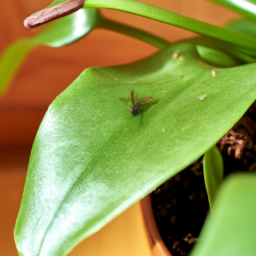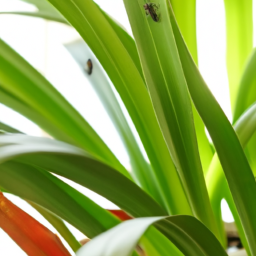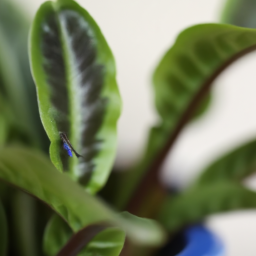
Hey there plant lovers! If you’re anything like me, you probably have a few indoor plants scattered around your home, bringing life and freshness to your living spaces. But, let’s face it, sometimes those beautiful green companions can come with a not-so-pleasant surprise: gnats. Yes, it’s true, indoor plants have gnats, and it’s a common issue that many plant enthusiasts have to deal with. But fear not, because in this blog post, we’re going to explore the reasons behind this pesky problem and provide you with some practical tips on how to get rid of those tiny flying nuisances. So, grab your watering can and let’s dive into the world of indoor plants and their gnat companions!
How to Prevent and Get Rid of Gnats in Indoor Plants
Gnats can be a common nuisance when it comes to indoor plants. These tiny flies can quickly multiply and infest your beloved greenery, causing damage to the plants and frustration for the plant owner. However, with the right preventive measures and effective treatment methods, you can easily get rid of gnats and keep your indoor plants healthy. In this guide, we will explore the various steps you can take to prevent and eliminate gnats in your indoor plants.
Understanding Gnats and their Lifecycle
Before we delve into the prevention and eradication strategies, it’s important to understand the lifecycle of gnats. Gnats are small, flying insects that belong to the family of flies. They are attracted to moist environments and organic matter, which makes potted plants an ideal breeding ground for them. Gnats lay their eggs in the soil, and once hatched, the larvae feed on decaying plant matter and roots. These larvae then pupate and eventually emerge as adult gnats, continuing the cycle.
Now that we have a basic understanding of gnats and their lifecycle, let’s move on to the preventive measures you can take to keep them away from your indoor plants.
Preventive Measures
1. Use High-Quality Potting Soil: One of the best ways to prevent gnats in indoor plants is to start with high-quality potting soil. Gnats are often introduced to your plants through contaminated soil. Look for soil mixes that are specifically formulated for indoor plants and ensure they are free from pests and diseases.
2. Allow Proper Drainage: Gnats thrive in moist environments, so it’s crucial to provide proper drainage for your indoor plants. Ensure that your pots have drainage holes at the bottom and use well-draining potting soil. Avoid overwatering your plants, as excess moisture can create the perfect breeding ground for gnats.
3. Keep the Area Clean: Maintaining cleanliness around your indoor plants is essential to prevent gnats. Regularly remove fallen leaves, dead flowers, and any decaying organic matter from the soil surface. Gnats are attracted to these organic materials, so keeping the area clean will discourage them from laying their eggs.
4. Avoid Overwatering: Overwatering not only creates a favorable environment for gnats but also harms your plants. Before watering, always check the moisture level of the soil by inserting your finger about an inch deep. If it feels dry, it’s time to water. Avoid letting the soil become waterlogged, as this can lead to root rot and attract gnats.
5. Use Yellow Sticky Traps: Yellow sticky traps can be an effective tool to trap adult gnats. These traps are coated with a sticky substance that attracts gnats, causing them to get stuck. Place the traps near your plants to catch the flying gnats and prevent them from laying eggs in the soil.
6. Introduce Beneficial Insects: Another natural way to control gnats in indoor plants is by introducing beneficial insects that prey on them. For example, predatory mites and nematodes feed on gnat larvae, helping to reduce their population. You can purchase these beneficial insects from gardening stores and release them in your plant’s environment.
Treating a Gnat Infestation
If despite your best efforts, you find your indoor plants infested with gnats, it’s important to take immediate action to eliminate them. Here are some effective treatment methods:
1. Neem Oil: Neem oil is a natural insecticide that can help control gnats in indoor plants. Mix a few drops of neem oil with water and spray it on the affected plants, focusing on the soil surface. The oil will disrupt the gnat’s lifecycle and prevent them from reproducing.
2. Hydrogen Peroxide: Hydrogen peroxide can be an effective remedy for gnat-infested plants. Mix one part hydrogen peroxide with four parts water and pour the solution into the soil. The hydrogen peroxide will kill the larvae and disrupt their lifecycle.
3. Sticky Traps: In addition to using yellow sticky traps for prevention, you can also place them strategically around your plants to catch adult gnats. This will help reduce their population and prevent further infestation.
4. Allow the Soil to Dry: Since gnats thrive in moist environments, allowing the soil to dry out can be an effective way to get rid of them. Adjust your watering schedule and only water your plants when the top inch of soil feels dry. This will help kill the larvae and discourage adult gnats from laying eggs.
5. Repotting: If the infestation is severe and other methods haven’t been successful, you may need to repot your plant. Carefully remove the plant from its current pot, shake off the old soil, and inspect the roots for any signs of damage or larvae. Repot the plant in fresh, sterile soil to give it a fresh start.
By following these preventive measures and treatment methods, you can effectively prevent and eliminate gnats in your indoor plants. Remember to be patient and consistent in your efforts, as it may take some time to completely eradicate the infestation. With proper care and attention, you can enjoy a thriving indoor garden free from gnats.

Common Causes and Solutions for Gnats Infestation in Houseplants
Gnats, those tiny flying insects that seem to appear out of nowhere, can be a frustrating nuisance when they infest your indoor plants. Not only are they annoying, but they can also cause damage to your beloved greenery if left untreated. In this article, we will explore the common causes of gnats infestation in houseplants and provide you with step-by-step solutions to get rid of these pesky pests.
Causes of Gnats Infestation
Gnats are typically attracted to moist environments, making your indoor plants an ideal breeding ground for them. Here are some common causes of gnats infestation in houseplants:
1. Overwatering: One of the primary reasons gnats thrive in indoor plants is overwatering. When the soil remains constantly wet, it creates the perfect conditions for gnats to lay their eggs. The larvae feed on decaying organic matter in the soil, further exacerbating the infestation.
2. Poor Drainage: Inadequate drainage in your plant pots can lead to water accumulation, creating a moist environment that attracts gnats. Ensure that your pots have proper drainage holes and use well-draining soil to prevent waterlogging.
3. Infected Potting Soil: Sometimes, the potting soil itself can be the source of the gnat infestation. If you notice gnats emerging from the soil bag or notice small black insects crawling around, it’s likely that the soil is already contaminated.
Solutions to Get Rid of Gnats
Now that we understand the common causes of gnats infestation, let’s dive into the solutions to eliminate these pesky insects from your indoor plants:
1. Allow the Soil to Dry Out: Gnats thrive in moist environments, so allowing the soil to dry out between waterings is crucial. Stick your finger into the soil up to your knuckle, and if it feels dry, it’s time to water your plant. Avoid overwatering, as it not only attracts gnats but can also harm your plants.
2. Improve Drainage: Ensure that your plant pots have proper drainage holes to allow excess water to escape. You can also add a layer of small rocks or pebbles at the bottom of the pot to enhance drainage. Additionally, consider repotting your plants using well-draining soil to prevent waterlogging.
3. Use Sticky Traps: Sticky traps are a simple yet effective way to catch adult gnats. These traps consist of yellow or blue sticky cards that attract gnats, causing them to get stuck. Place the traps near your plants to trap the flying insects and monitor their population.
4. Apply Neem Oil: Neem oil is a natural and safe insecticide that can help control gnats infestation. Mix a few drops of neem oil with water and spray it onto the soil surface and leaves of your plants. The oil disrupts the gnats’ life cycle, preventing them from reproducing and eventually eliminating the infestation.
5. Allow for Natural Predators: Introducing natural predators, such as beneficial nematodes or predatory mites, can help control the gnat population. These tiny organisms feed on the larvae and pupae of gnats, reducing their numbers. You can purchase these predators online or from specialized gardening stores.
6. Avoid Overfertilizing: Overfertilizing your plants can lead to an excess of organic matter in the soil, providing ample food for gnats. Follow the recommended fertilization guidelines for your specific plants and avoid using fertilizer excessively.
7. Quarantine Infested Plants: If you notice a severe infestation in one of your plants, it’s best to isolate it from the rest. Quarantining the infested plant prevents the gnats from spreading to other healthy plants, giving you a better chance of controlling the infestation.
By following these steps and implementing the suggested solutions, you can effectively eliminate gnats from your indoor plants. Remember, consistency is key, as it may take some time to completely eradicate the infestation. With a little patience and diligence, you’ll soon have gnat-free and thriving houseplants once again.

Best Practices for Maintaining Gnat-Free Indoor Plant Environments
Indoor plants can bring life and beauty to any space, but they can also attract unwanted pests like gnats. Gnats are small flying insects that can be a nuisance and cause damage to your plants if left uncontrolled. In this guide, we will discuss the best practices for maintaining gnat-free indoor plant environments, so you can enjoy your greenery without any unwanted visitors.
Identifying Gnats and Understanding Their Behavior
Before diving into the best practices for eliminating gnats from your indoor plants, it is important to understand these pests and their behavior. Gnats are small, flying insects that are commonly found around plants. They are attracted to moist soil and decaying organic matter, which makes indoor plants an ideal breeding ground for them.
Gnats lay their eggs in the soil, and once hatched, the larvae feed on organic matter and plant roots. This can lead to stunted growth, yellowing leaves, and overall decline in plant health. Adult gnats are usually harmless to plants but can be a nuisance as they fly around your living space.
To identify gnats, look for tiny black or gray insects flying around your plants or resting on the soil surface. You may also notice small, clear or white larvae in the soil. It is essential to take action as soon as you spot these pests to prevent an infestation from spreading.
Implementing Effective Prevention Measures
Prevention is key when it comes to maintaining gnat-free indoor plant environments. By implementing the following measures, you can significantly reduce the chances of a gnat infestation:
1. Proper Watering Techniques: Overwatering is a common cause of gnat problems. Allow the top inch of soil to dry out before watering your plants again. This will help prevent the soil from becoming overly moist, which attracts gnats.
2. Use Well-Draining Soil: Gnats thrive in damp soil, so using a well-draining potting mix can help prevent their presence. Look for soil mixes that contain perlite or vermiculite, as they improve drainage and allow excess water to flow through.
3. Remove Decaying Organic Matter: Regularly inspect your plants for decaying leaves, fallen flowers, or any other organic matter. Remove them immediately to eliminate a potential food source for gnats.
4. Avoid Overcrowding: Overcrowded plants not only compete for resources but also create a humid environment that attracts gnats. Give your plants enough space to grow and ensure proper air circulation around them.
5. Cleanliness is Key: Keep your indoor space clean and free from debris. Regularly sweep or vacuum the area around your plants to remove any fallen leaves or dirt that may attract gnats.
Effective Gnat Control Methods
If you already have a gnat problem, don’t worry! There are several effective methods to control and eliminate these pests:
1. Sticky Traps: Place sticky traps near your plants to catch adult gnats. These traps are coated with a sticky substance that attracts and captures the insects when they land on it.
2. Yellow Sticky Cards: Similar to sticky traps, yellow sticky cards are highly effective in catching adult gnats. The bright yellow color attracts the insects, and they get stuck to the adhesive surface.
3. Neem Oil: Neem oil is a natural insecticide that can be used to control gnats. Mix a few drops of neem oil with water and spray it on the soil surface. The oil disrupts the gnat’s life cycle and prevents them from reproducing.
4. Hydrogen Peroxide Solution: Mix one part hydrogen peroxide with four parts water and water your plants with this solution. The hydrogen peroxide kills the larvae and prevents them from developing into adult gnats.
5. Soil Drenching: If the gnat infestation is severe, you can try soil drenching. Mix an insecticide specifically formulated for gnats with water and pour it into the soil. Follow the instructions on the product label for the correct dosage.
Remember to always read and follow the instructions on any pest control product you use, and consider using natural remedies before resorting to chemical solutions.
By implementing these best practices and being proactive in preventing and controlling gnat infestations, you can maintain a gnat-free indoor plant environment. Enjoy the beauty of your indoor plants without the hassle of these pesky insects!
Key Takeaways
Indoor plants are a fantastic way to bring the beauty of nature into our homes. They not only add a touch of greenery but also purify the air and create a calming atmosphere. However, if you’ve noticed tiny flying insects buzzing around your beloved indoor plants, you’re not alone. These pesky creatures are known as gnats, and they can quickly become a nuisance. But fear not, there are simple solutions to get rid of them and keep your indoor plants thriving.
Gnats are attracted to the moist soil of indoor plants, where they lay their eggs. The larvae then feed on the decaying organic matter found in the soil, which can harm the roots of your plants. To tackle this issue, start by letting the soil dry out between watering sessions. Gnats thrive in damp conditions, so allowing the top inch of the soil to dry out will discourage them from laying eggs. Additionally, you can create a homemade gnat trap by filling a small container with apple cider vinegar and a few drops of dish soap. The gnats will be lured by the vinegar scent and get trapped in the soapy solution. By implementing these simple measures, you can bid farewell to those pesky gnats and enjoy your indoor plants without any unwelcome buzzing.
Q&A Corner:
Q1: Why do indoor plants attract gnats?
A1: Indoor plants can attract gnats due to several reasons. One common reason is overwatering your plants, which creates a moist environment that gnats thrive in. Additionally, decaying organic matter in the soil can also attract gnats. Moreover, bringing outdoor plants inside without properly inspecting them can introduce gnats to your indoor environment.
Q2: How can I get rid of gnats in my indoor plants?
A2: There are a few effective methods to get rid of gnats in your indoor plants. Firstly, you can let the soil dry out between watering sessions to discourage gnat breeding. Another approach is to use yellow sticky traps, which attract and capture adult gnats. You can also try placing a layer of sand or gravel on top of the soil to prevent gnats from laying eggs. Additionally, using a mixture of water and dish soap as a spray can help eliminate adult gnats.
Q3: Are gnats harmful to indoor plants?
A3: While gnats themselves may not directly harm indoor plants, their larvae can cause damage. Gnat larvae feed on the roots of plants, which can lead to root rot and hinder the plant’s growth. Furthermore, the presence of gnats can be a sign of other underlying issues, such as overwatering or poor soil drainage, which can negatively impact the health of your plants.
Q4: How can I prevent gnats from infesting my indoor plants?
A4: To prevent gnats from infesting your indoor plants, there are a few proactive steps you can take. Firstly, avoid overwatering your plants and make sure the soil has proper drainage. It’s also beneficial to inspect any new plants before bringing them indoors, as they may already have gnats or gnat eggs. Additionally, maintaining a clean and tidy indoor environment, free from decaying organic matter, can discourage gnats from breeding.
Q5: Can I use natural remedies to control gnats in my indoor plants?
A5: Yes, there are several natural remedies you can use to control gnats in your indoor plants. One effective option is using a mixture of water and hydrogen peroxide to water your plants. This solution helps kill gnat larvae in the soil. Another natural remedy is using neem oil, which acts as a repellent and disrupts the gnat life cycle. Additionally, you can introduce beneficial nematodes to the soil, as they prey on gnat larvae and help control their population.

James Wong is a renowned ethnobotanist, plant scientist, and local television presenter. With a passion for demystifying plant science, he is known for translating complex botanical concepts into practical advice for everyday plant enthusiasts. James’s expertise spans from traditional gardening to cutting-edge plant technologies, making his insights accessible and informative.


